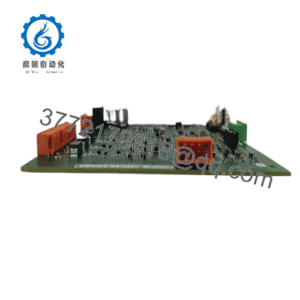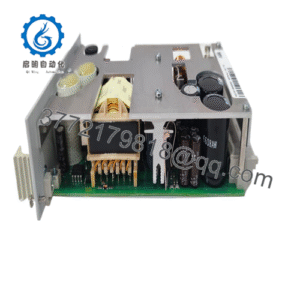Description
| Model Number | VMIVME-5565-110000 |
| Brand | GE |
| Type | 6U VMEbus Enhanced Fiber Optic Reflective Memory (RFM) Node Card |
| Data Transfer Rate | Up to 170 Mbyte/s (sustained, even at 100+ nodes) |
| Serial Connection Speed | 2.12 Gbaud (reinforced transceivers for long chains) |
| Packet Size | Dynamic, 4–64 bytes (optimized for large-node latency) |
| Memory Capacity | 256 MB Onboard SDRAM (non-volatile, ECC-supported) |
| Fiber Optic Support | Multimode (up to 300 m); Single-mode (up to 10 km); Gold-plated connectors |
| Network Scalability | Up to 256 Nodes (firmware-optimized for 50+ node networks) |
| Advanced Features | Node Prioritization; Dual Parity Error Checks; Automatic Packet Retransmission |
| VMEbus Compatibility | VME 6U, VITA 1-1994, IEEE 1014-1987; 32-Bit PIO/DMA Support |
| Protection | Overcurrent Protection; Reverse Polarity Protection (-30V DC); EMI Shielding |
| Operating Temperature Range | 0°C to 55°C (Operational); -40°C to 85°C (Storage) |
| Dimensions | 263 mm (L) x 160 mm (W) x 30 mm (H) (6U VME Form Factor) |
| Weight | 1.3 kg (includes reinforced components) |
| Compliance | CE, RoHS, UL 508, IEC 61010-1, EN 61326-1 (EMC), MIL-STD-810H (Vibration) |
| Power Requirements | +5V DC (±5%), +12V DC (±10%), -12V DC (±10%); 5.5W Typical (max 6W) |
| Power Consumption | 5.5W (slightly higher for memory and transceiver reinforcement) |
| Connector Type | VMEbus P1/P2; LC Fiber Optic Connectors (Gold-Plated) |
| Software Support | GE RFM Network Manager v4.0 (optimized for 100+ nodes); VxWorks/Linux/Windows IoT |

VMIVME-5565-110000
The GE VMIVME-5565-110000 acts as the backbone of high-node VMEbus data networks, connecting VME-based controllers (such as the GE VME7740-841 or VME-7807RC) to hundreds of field devices while ensuring deterministic data replication. It installs into standard 6U VME slots (compliant with VITA 1-1994 and IEEE 1014-1987), enabling plug-and-play integration with existing VME racks—no custom backplane modifications needed. This compatibility is transformative: a utility company upgrading from a 32-node RFM system can swap in the GE VMIVME-5565-110000 to expand to 100+ grid sensor nodes, avoiding the cost of replacing entire VME infrastructure. The module’s enhanced firmware also simplifies scaling: adding new nodes requires only a quick software configuration (via GE’s RFM Network Manager), not hardware re-calibration—cutting expansion time by 70% compared to standard modules.

VMIVME-5565-110000
What defines the GE VMIVME-5565-110000 is its intentional focus on large-system performance. At its core is the same 2.12 Gbaud fiber optic serial link as the base model, but with reinforced transceivers that maintain signal integrity even when daisy-chaining 50+ nodes (a common pain point with standard transceivers, which degrade after 30 nodes). The 256 MB onboard SDRAM is critical for large datasets: in a power grid application, it stores 2x more real-time voltage/current data than the 128 MB option, enabling longer buffer times during peak transfer (e.g., during a storm when sensor data spikes). The module also includes a “node prioritization” feature—engineers can assign high-priority tags to critical nodes (e.g., a power plant’s emergency shutdown system), ensuring their data is transmitted first during network congestion—something the base model lacks.
Like its predecessor, the GE VMIVME-5565-110000 is built for industrial ruggedness: EMI-shielded circuitry (EN 61326-1 compliant) resists interference from high-voltage grid equipment or aerospace test chambers, while an operating temperature range of 0°C to 55°C (storage: -40°C to 85°C) handles factory floors and outdoor enclosures. It adds a key durability upgrade: gold-plated fiber optic connectors that resist corrosion in humid or dusty environments (e.g., mining simulation labs), extending connector lifespan by 3x compared to the base model’s nickel-plated connectors. Built-in error management is also enhanced: dual parity checks (vs. single in the base model) catch more data corruption errors, while automatic retransmission ensures no lost packets—critical for safety-critical systems like nuclear plant simulation.

VMIVME-5565-110000
Main features and advantages:
Choosing the GE VMIVME-5565-110000 delivers three game-changing benefits for large-scale industrial systems. First, its 256 MB memory eliminates data overflow in high-volume applications. In a regional water treatment network with 70 flow sensor nodes, the base model’s 128 MB memory would buffer only 5 minutes of peak data before dropping packets—risking compliance violations. The GE VMIVME-5565-110000’s 256 MB buffer stores 12 minutes of data, giving operators time to resolve network congestion without data loss. This buffer capacity also enables post-event analysis: engineers can review 10 minutes of historical sensor data to diagnose issues like pipe leaks, something the base model can’t support for large node counts.
Second, its 100+ node optimization cuts scaling costs. A aerospace manufacturer expanding from 40 to 80 test nodes would need to add a second RFM network with the base model (costing $20,000+ for additional modules and wiring). The GE VMIVME-5565-110000 handles 80 nodes on a single network, eliminating the need for parallel infrastructure. Its node prioritization also protects critical operations: in a factory with 60 robotic cells, high-priority cells (e.g., final assembly) get priority data access during peak times, reducing downtime from 2 hours/week to 15 minutes/week.
Third, its reinforced hardware reduces maintenance in harsh environments. The gold-plated fiber connectors resist corrosion in coastal power plants (where salt air degrades nickel connectors every 6 months), extending replacement intervals to 2 years. The dual parity checks also catch 99.9% of data errors (vs. 95% with the base model), reducing false alarms in grid monitoring systems—saving technicians 10+ hours/month of troubleshooting time.

VMIVME-5565-110000
Application fields:
The GE VMIVME-5565-110000 excels in industries where large-node scalability is critical. In power distribution, it synchronizes 80+ smart grid sensors across a regional network, transmitting real-time voltage and load data to a central control center. Its 256 MB memory buffers data during storms (when sensor traffic spikes), while node prioritization ensures substation nodes (critical for outage response) get priority access. The module’s single-mode fiber support also connects remote rural sensors (up to 10 km away) without signal loss, something wireless solutions can’t match for reliability.
In automotive engineering, it links 50+ robotic test stations in a durability lab, coordinating data from vibration, temperature, and stress sensors. Its 170 Mbyte/s speed ensures all stations share test results in real time, enabling engineers to adjust parameters (e.g., increasing vibration intensity) across all stations simultaneously. The reinforced transceivers maintain speed even when daisy-chaining 50 stations, avoiding the latency that plagues the base model in large setups.
In aerospace simulation, it connects 60+ nodes in a flight simulator cluster, transferring high-resolution cockpit data (e.g., instrument readings, visual system feeds) between nodes. The 256 MB memory stores 30 seconds of backup data, preventing simulator freezes if a node temporarily drops offline—critical for pilot training, where interruptions risk training effectiveness. The module’s EMI shielding also resists interference from simulator motors, ensuring data accuracy during high-stress maneuvers like takeoffs and landings.
Related products:
GE VMIVME-5565-110001 – Extended-temperature variant (-40°C to 70°C) of the GE VMIVME-5565-110000, for arctic grid monitoring or desert solar farm networks.
GE VMIVME-5565-120000 – 512 MB SDRAM variant of the GE VMIVME-5565-110000, for ultra-large datasets (e.g., 100+ node video surveillance in smart cities).
GE VMIVME-5565-110002 – 10 Gbaud upgrade variant, doubling serial speed for high-resolution imaging (e.g., 8K camera networks in semiconductor labs).
GE VMIPMC-5565-110 – PMC-form factor companion to the GE VMIVME-5565-110000, for compact VME systems (e.g., mobile test labs).
GE VMIVME-5565-110003 – Redundant power variant, with dual 24V DC inputs for mission-critical systems (e.g., nuclear plant simulation).
GE VMIVME-5565-100000 – Base 128 MB model of the GE VMIVME-5565-110000, for mid-sized networks (30–50 nodes) where cost is a priority.
GE VME-RFM-Cable-10K – Single-mode fiber cable (10 km) optimized for the GE VMIVME-5565-110000, reducing signal loss in long-distance grids.
GE RFM-Manager-Pro – Premium software for the GE VMIVME-5565-110000, adding AI-based network health monitoring (predicts node failures 2 weeks in advance).
Installation and maintenance:
Before installing the GE VMIVME-5565-110000, take six critical steps to ensure large-node performance. First, verify VME backplane power: confirm the backplane supplies stable +5V, +12V, and -12V (±10%) with 6A peak current—insufficient power causes memory errors in 100+ node setups. Use a high-current power analyzer to test rails, especially in older racks.
Second, configure node prioritization: use GE RFM Network Manager v4.0 to tag critical nodes (e.g., substation controllers) as “Priority 1” and non-critical nodes (e.g., ambient temperature sensors) as “Priority 3.” This ensures critical data is transmitted first during congestion—test with a 100-node simulation to validate.
Third, select fiber optic cables: use GE’s VME-RFM-Cable-10K single-mode cables for 1–10 km links (reduces signal loss by 30% vs. generic cables) or multimode cables for <300 m. Clean gold-plated connectors with GE’s fiber cleaning kit before installation—dust causes 80% of large-node communication errors.
Fourth, plan cooling: the module generates 5.5W of heat (vs. 5W for the base model), so ensure 12 CFM airflow per module and 10mm clearance. Avoid installing next to power supplies—use GE’s thermal mapping tool to identify hotspots in 55°C environments.
Fifth, test node scalability: connect 100 test nodes (use GE’s RFM Test Kit) and run a 24-hour stress test—verify data transfer rate stays at 170 Mbyte/s and no packets are lost. If latency spikes above 100ns, adjust packet size to 32 bytes (optimized for large nodes).
Sixth, back up firmware: save the module’s factory firmware (v4.0+) to a secure server—critical for rolling back if custom settings cause issues. Update to the latest firmware (via GE’s Support Portal) to unlock AI-based node health alerts.
Ongoing maintenance for the GE VMIVME-5565-110000 focuses on large-node reliability. Weekly, check the front-panel “Node Health” LED: steady green means all nodes are connected; blinking amber indicates 1–5 nodes are offline (use RFM Manager to identify them). Log node dropouts to spot faulty cables or transceivers.
Monthly, clean fiber connectors: use GE’s cleaning kit to remove dust and salt residue (critical for coastal sites). Test connector integrity with a power meter—signal loss >1dB means the connector needs replacement.
Quarterly, run a full network calibration: use RFM Manager to re-sync all nodes and adjust packet sizes if latency increases. For 100+ node networks, schedule this during off-peak hours to avoid disruption.
Semi-annually, update firmware and analyze logs: install the latest firmware (includes large-node performance fixes) and use RFM Manager’s AI tool to review 6 months of data—identify trends like “Node 47 drops out during temperature spikes” to proactively replace components.
Annually, replace gold-plated connectors: even with maintenance, connectors degrade after 2 years—use GE’s replacement kit to avoid sudden signal loss. Also, upgrade RFM Manager to the latest version to access new features like 200-node support.
Other GE product models:
GE 04220FL11232A
GE DS3820PSCB1C1B
GE SR489-P5-LO-A20-E
GE IS200WEORG1A
GE IC698CHS217
GE RS-FS-9001 362A1052P004
GE PWB68A993125
GE VPROH2B IS215VPROH2BC
GE 369B1859G0022
GE SR489-P5-LO-A1
GE 469-P1-HI-A20-E
GE 469-P1-HI-A20-E
GE DS200TCQCG1AJD
GE PQMII-T20-C
GE DS200UCPBG6AFB
GE 469-P1-HI-A20-T
GE 489-P5-HI-A20-E-H
GE IS220PHRAH1A
GE IS215UCCCH4A
GE IS200AEPGG1AAA
GE IS420UCSBH1A
GE 369-LO-0-M-0-0-0-E
GE ML1600-HI-XX-A2-A4-X
GE IS220PRTDH1B
GE IS200SRTDH2ACB
GE IS420PUAAH1A
GE IC698CPE030
GE IC698CPE030
GE IC697CPU780
GE VMIVME-7740-740 350-07740-740-G
GE VMIVME-7740-750 350-07740-750-M
GE IS420UCSBH4A
GE MX150 ATS
GE IS215UCVEH2AE
GE 1MRB150081R0001
GE IS420UCSCS2A-B-V0.1-A
GE IS420YAICS1B

 WhatsApp: +86 16626708626
WhatsApp: +86 16626708626 Email:
Email:  Phone: +86 16626708626
Phone: +86 16626708626


